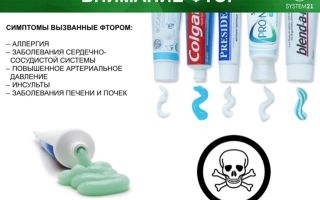Content
- 1 The role of fluoride in the human body
- 2 The benefits of fluoride for teeth
- 3 Varieties of toothpastes with fluoride compounds
- 4 Fluoride in children's toothpastes
- 5 The harm of fluoride toothpaste
- 6 What foods contain fluoride
- 7 Fluoride Poisoning Symptoms
- 8 How to remove fluoride from the body
- 9 How to choose a toothpaste
- 10 The best fluoride toothpastes
- 11 How to brush your teeth properly
- 12 How to choose a brush
- 13 Conclusion
Fluorine is an essential trace element for the human body. It is necessary for the safe functioning of almost all organs and systems. Including for teeth. But few people realize what the benefits and harms of fluoride in toothpaste are.
The role of fluoride in the human body
Everyone knows about the existence of fluoride since school. After all, this is one of the elements of the periodic table. In many sources, it is denoted by the letter F, as in the table. Pure fluorine is a poisonous and corrosive gas for the human body. But in all products, toothpaste, the element is contained in the form of salts - sodium fluoride and calcium fluoride. Then, on the contrary, it benefits the body.

The benefits of the trace element fluoride for the human body are extremely great. It is essential for normal bone mineralization. The substance gives bones strength, firmness and elasticity. Under the influence of fluorides, the growth of nails and hair is activated. Other useful properties of the trace element are less pronounced, but they take place:
- increasing the body's resistance to pathogenic microorganisms;
- strengthening of immunity;
- stimulation of the formation of blood cells in the bone marrow;
- cleansing the body of heavy metals.
The benefits of fluoride for teeth
The use of fluoride in toothpaste is to protect teeth from caries, strengthen enamel, and suppress the reproduction of pathogenic microflora. The trace mineral also prevents the release of calcium from the teeth.
Protects teeth from caries
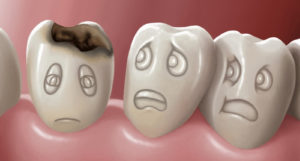
The enamel of the tooth surface is constantly exposed to acids contained in the oral cavity. With prolonged interaction, the crystal lattice of the enamel splits. A cavity is formed that turns black over time. This is how caries develops.
A useful property of fluorides in toothpaste is that it penetrates the enamel crystal lattice and makes it more resistant to acidic environments. Moreover, it is effective not only for prevention, but also for the treatment of caries in the early stages. If the caries is superficial and does not penetrate deep into the tooth, you can try fluoride toothpaste therapy. But, most likely, you will have to resort to additional methods of treatment.
Prevents decalcification
The undoubted benefit of fluorides for bone tissue and teeth is the mobilization of calcium in them. The trace element promotes the transfer of ions from the blood to the tissues of the body. This process is called remyelination. On the other hand, saliva produced during food contributes to demyelination, or decalcification.
When entering the body, calcium and phosphorus ions are integrated into the enamel crystal lattice in a larger amount than usual.This prevents them from dissolving during saliva production. Thus, phosphorus protects teeth from decalcification.
Strengthens the enamel
The main component of the enamel is calcium hydroxyapatite. The fluoride contained in the toothpaste comes into contact with the crystal lattice of this salt. A new compound is formed - fluorine hydroxyapatite. That is, the trace element replaces calcium. The new formation is more durable and resistant to oral acids.
Prevents the growth of pathogenic microflora
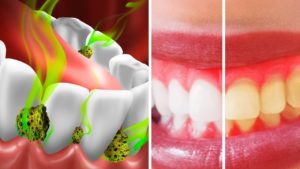
Another beneficial effect of fluoride on teeth is the inhibition of the growth of pathogenic microorganisms contained in dental plaque. In the course of their vital activity, bacteria secrete special enzymes necessary for the breakdown of carbohydrates and their absorption. Fluoride can interfere with the production of these enzymes. Thus, the growth of pathogenic microflora stops.
Prevents the formation of lactic acid
The ability of the trace element to prevent the synthesis of lactic acid comes from its ability to inhibit the growth of bacteria. Microorganisms produce lactic acid during growth and reproduction. This substance has a detrimental effect on the structure of tooth enamel. By preventing the formation of lactic acid, fluoride protects the enamel.
Varieties of toothpastes with fluoride compounds
Fluoride pastes belong to the group of therapeutic and prophylactic hygiene products. Depending on what kind of salt is present in the composition, such fluorine-containing pastes are distinguished:
- with aminofluoride;
- sodium fluoride;
- sodium monofluorophosphate;
- tin fluoride.
Fluoride in children's toothpastes
When choosing a cleaning agent for a child, it is necessary to correctly assess the possible harm and benefits of fluoride in toothpaste. Young children swallow 60% or more of the toothpaste while brushing their teeth. And an excess of a trace element is very harmful to the body. The World Health Organization has established that it is recommended for children to use hygiene products with a fluoride content of no more than 1500 ppm.
A useful property of toothpastes with fluoride is an effective prevention of dental caries in children. But they should only be used in short courses if indicated.
The harm of fluoride toothpaste
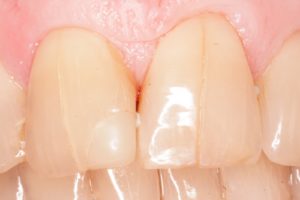
The danger of fluoride in toothpaste manifests itself with an excess of a trace element. This condition is called fluorosis. With an excess intake of a substance into the body, it is slowly excreted. Most of the fluoride is deposited in bone tissue and teeth. Scientists recently discovered that they also accumulate in the structures of the central nervous system. The pineal gland suffers the most.
The first manifestations of fluorosis appear on the teeth, namely their buccal surface. The incisors of the upper jaw are most often affected, less often the lower. With a further increase in the concentration of fluoride in the body, the remaining teeth are affected. Tooth enamel wears off, cracks and erosion appear on it.
What foods contain fluoride
Fluoride is most beneficial for people who have a deficiency of this trace element. This population group is advised to consume foods rich in fluoride and drink bottled water. Below is a table of the most saturated elements of the products and the concentration of fluorine in them.
|
Product |
Fluorine content in 1 mg |
|
Cod |
0,1 |
|
Sea bass |
0,2 |
|
Herring |
0,525 |
|
Salmon |
0,21 |
|
Acne |
0,23 |
|
Chicken breast |
0,21 |
|
Chicken liver |
0,19 |
|
Buckwheat grain |
0,1 |
Sufficient trace element content in green tea, parsley. Besides fish, seafood is also rich in it:
- shrimp;
- mussels;
- seaweed.

The endemic regions of the country are distinguished separately. In such areas, the natural content of fluorine is insufficient. Therefore, people suffer from a chronic deficiency of the element. In this case, food and water are specially enriched with fluorine, that is, they are fluoridated.
Fluoride Poisoning Symptoms
Fluoride is a very insidious trace mineral. At the right dosage, it brings a ton of benefits to the body. But even the smallest overdose is very harmful.
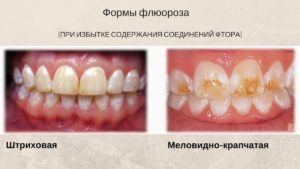
Depending on the manifestations of fluorosis, several of its forms are distinguished:
- dashed;
- spotted;
- chalk-speckled;
- erosive;
- destructive.
The dashed variety of an excess of fluorine is characterized by the appearance of stripes and stripes of various shapes on the incisors. They are most often seen after drying your teeth. In severe streak fluorosis, the stripes are more noticeable. Sometimes individual strokes merge to form spots. But upon closer examination, stripes can be differentiated in spots.
The spotted form, according to the name, is characterized by the formations of small light spots. They can coalesce to form one large spot. The stripes are not visible.
In the chalky-speckled form, the teeth acquire a matte, sometimes yellowish, shade. On the surface of the enamel there are many spots and dots with clear boundaries. This is one of the most unfavorable forms of fluorosis. Enamel is quickly erased with her. Brown dentin begins to protrude outward.
In the erosive form, the enamel is damaged with the formation of many specks. The chewing surface of the teeth suffers the most. Destructive fluorosis is the most severe. The tooth is very fragile; at the slightest pressure, it is destroyed.
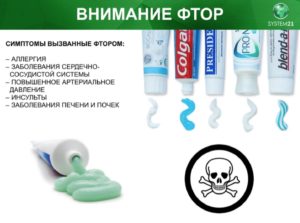
In addition to dental tissue, the skeleton suffers from fluoride poisoning. Osteoporosis develops (softening of the bones with leaching of calcium from them), the function of the joints is disrupted until they are completely immobilized (ankylosis). In advanced cases, liver function is damaged.
How to remove fluoride from the body
There are some simple remedies that can help flush excess fluoride from your body. But these methods are effective only for mild fluorosis. Therefore, intoxication must be diagnosed as early as possible.
Before using any method, you should completely stop contacting the body with a trace element: give up fluoridated foods and water, stop brushing your teeth with fluoride paste. The main methods that can remove a substance from the body include:
- Iodine - increases the excretion of the element along with urine. The concentration of iodine in such products is high: lingonberries, strawberries, potatoes, beans.
- Boron - acts similarly to iodine. It is found in dates, honey, nuts, broccoli, avocado, and prunes.
- Selenium able to block the activity of fluoride in the body. It is obtained from the consumption of Brazil nuts.
- Dry saunas... Although this method may seem strange, intense sweating helps to flush toxic substances from the body. The main thing before taking a sauna is to make sure that the body is sufficiently hydrated to avoid dehydration.
How to choose a toothpaste
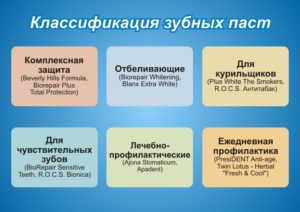
In order for brushing your teeth to bring only benefits, you need to responsibly approach the choice of toothpaste. It is best to consult a dentist. The specialist will assess the health of the teeth and select the desired paste. All toothpastes are divided into 3 types:
- Hygienic - created only for cleaning teeth from plaque and aromatizing the oral cavity.
- Therapeutic - contain special additives that interact with specific pathological processes of the teeth or oral cavity (antifungal, antibacterial).
- Treatment-and-prophylactic - prevent the development of dental tissue and periodontal diseases.
Depending on the desired effect and the condition of the teeth, the patient, together with the dentist, selects the required type of hygiene product.
The best fluoride toothpastes
There are many companies that make fluoride toothpastes. The most popular are the following manufacturers:
- Paradontax;
- Colgate;
- Blendamed;
- Sensodyne.
Paradontax with fluoride
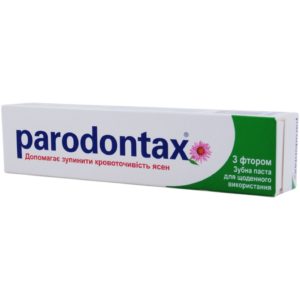
The manufacturer of Paradontax with fluoride claims that the benefits of this paste are to heal gums, eliminate bleeding. It also removes plaque and is effective in caries prevention. Customer reviews support this claim. They note that after a week of regular brushing with a paste 2 times a day, the bleeding disappears, and the teeth become whiter.
Colgate caries protection
Colgate is one of the most popular toothpaste manufacturers. He produces, among other things, hygiene products containing fluoride. This paste has beneficial properties for people with early caries. It effectively removes small blackheads from enamel.
Blendamed with active fluorine
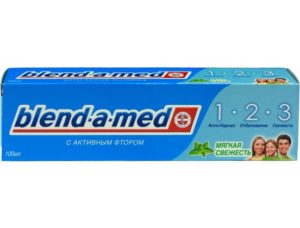
Blendamed with active fluorine is the optimal paste in terms of price and quality ratio. The low cost of a hygiene product does not negate its useful properties. There will be no snow-white Hollywood smile after using the paste, but it is effective for removing yellow plaque.
Sensodin with fluorine
Useful property of Sensodin toothpaste with fluoride is to reduce tooth sensitivity throughout the day. Moreover, its regular use prevents tooth decay. These effects are possible due to the sodium fluoride content.
How to brush your teeth properly
To get the maximum benefit and minimum harm from fluoride to your teeth, you must adhere to several rules:
- rinsing your mouth after brushing your teeth is not very intense;
- actively massage the areas of enamel affected by caries;
- before going to bed, apply a paste on the damaged enamel, since at night it is possible to reduce saliva secretion.
Dentists have proposed a technique that optimizes the effect of fluoride on the dentition:
- A minimum amount of paste is squeezed onto the toothbrush, corresponding to the size of a pea.
- Before cleaning, the paste is smeared over the enamel surface.
- Do not spit out the paste during cleaning.
- The teeth are rinsed for one minute after brushing.
- For an hour after the procedure, avoid food and drink water.
How to choose a brush
When choosing a toothbrush, consider the health of your gums and teeth. This will help determine the stiffness of the bristles. The bristles of medium hardness are considered to have the greatest number of useful properties and the most versatile. People with gum sensitivity should look for the softer options.
The handle of the brush should be long so that you can adjust the degree of pressure on the teeth. The most convenient options are with a movable head.
Conclusion
The benefits and harms of fluoride in toothpaste largely depend on the amount of trace element in the body. At optimal concentrations, it has many beneficial effects. But even a minor overdose is harmful. Therefore, if the slightest signs of fluoride intoxication appear, an urgent need to consult a doctor!

